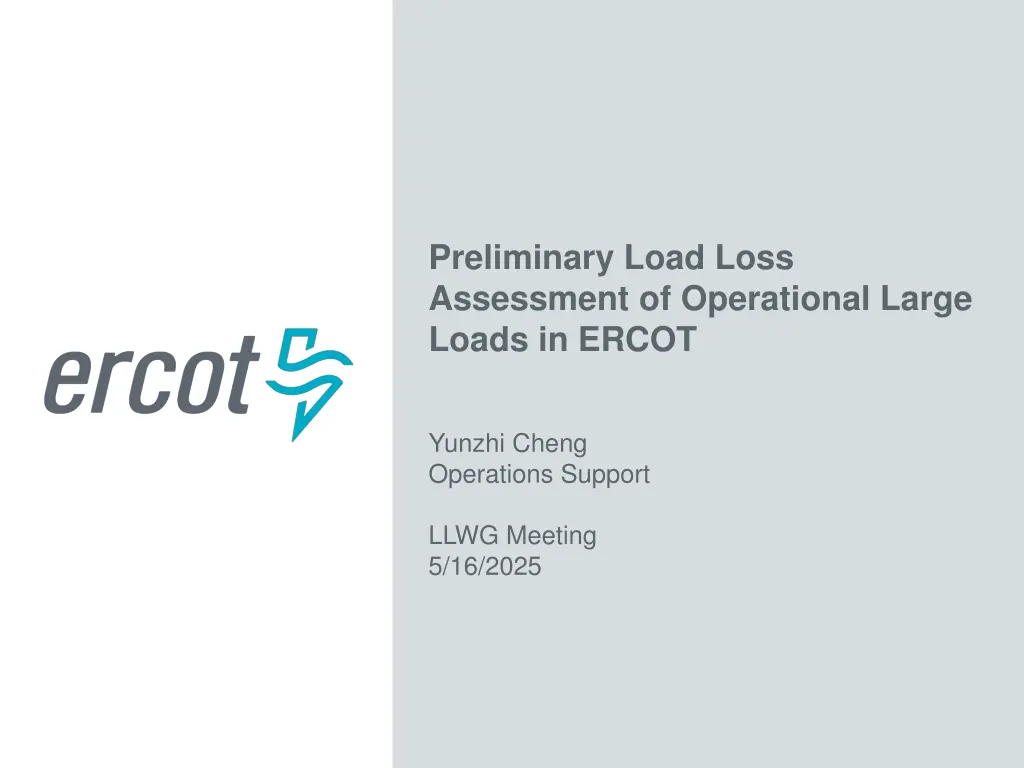
Preliminary Load Loss Assessment of Operational Large Loads in ERCOT
Conducted by Yunzhi Cheng, this assessment evaluates the impact of load loss on operational large loads in the ERCOT WTX zone. Findings reveal potential load loss scenarios during fault events and the influence of synchronous condensers on load shedding. Future work aims to explore fault locations and collaborate with the research community to enhance load behavior modeling.
Download Presentation

Please find below an Image/Link to download the presentation.
The content on the website is provided AS IS for your information and personal use only. It may not be sold, licensed, or shared on other websites without obtaining consent from the author. If you encounter any issues during the download, it is possible that the publisher has removed the file from their server.
You are allowed to download the files provided on this website for personal or commercial use, subject to the condition that they are used lawfully. All files are the property of their respective owners.
The content on the website is provided AS IS for your information and personal use only. It may not be sold, licensed, or shared on other websites without obtaining consent from the author.
E N D
Presentation Transcript
Preliminary Load Loss Assessment of Operational Large Loads in ERCOT Yunzhi Cheng Operations Support LLWG Meeting 5/16/2025
Operational Large Loads (LLs) in West Texas (WTX) 3,055MW ERCOT approved capacity for operational LLs in WTX load zone Non-Coincident peak observed: ~2,200MW PUBLIC
Study Assumptions Study Cases from DWG Summer Peak (SP) with 5,500MVA in-service synchronous generators in WTX High Renewable Minimum Load (HRML) with 900MVA in-service synchronous generators in WTX CTG 4-cycle (~66ms) 3P fault at a 345kV station in WTX without line tripping LL Voltage Tripping Settings for the Electronic Portion: 1#: 0.75pu instantaneous tripping, modeled as CMLD 2#: 0.7pu with 20ms delay (ITIC curve), modeled as UVLS since CMLD cannot model the time delay associated with tripping No reconnection of LL in both tripping settings PUBLIC
Preliminary Results Assuming a LL electric portion immediately trips if the voltage drops below 0.75pu, all the WTX LLs electronic portion will trip, leading to the total of loss of load of ~2,500MW Assuming a LL electric portion can ride through 0.7pu for 20ms (ITIC curve), the total of loss of load is reduced to ~1,500MW WTX LL Trip Assessment Results Tripping Amount (MW) Study Cases Voltage Trip Setting #1 (0.75pu, instantaneous) Voltage Trip Setting #2 (0.7pu, 20ms) SP ~1,500 ~1,500 ~2,500 HRML (All WTX LL electronic portion tripped) ~1,500 PUBLIC
Sensitivity Analysis Add SynCon (synchronous condenser) Add one SynCon at each LL POI bus with the size of ~1/3 of the LL MW, ~900MVA SynCons in total are added SynCons seem to have some impact on LL tripping, depending on the system condition and LL VRT capability WTX LL Trip Assessment Results (With SynCons) Tripping Amount (MW) Study Cases Voltage Trip Setting #1 (0.75pu, instantaneous) Voltage Trip Setting #2 (0.7pu, 20ms) SP ~1,500 n/a HRML ~1,900 ~1,300 PUBLIC
Preliminary Observations and Future Work ~2.5GW (all electronic portion) of loss of load observed with a 3P fault at a 345kV station in WTX if each LL cannot ride through an instantaneous 0.75pu voltage dip ~1.5GW of loss of load observed with a 3P fault at a 345kV station in WTX if each LL can ride through 0.7pu voltage dip for 20ms (ITIC curve) Synchronous condensers seem to have some impact on LL tripping, depending on the system condition and LL VRT capability Future work Investigate different fault locations Work with the research community and industry to understand more about LL behavior and models PUBLIC

